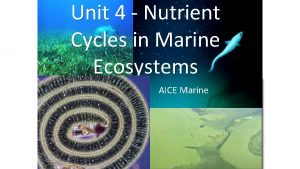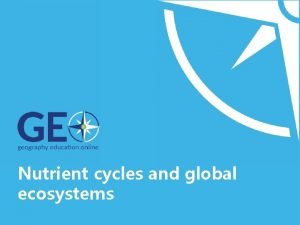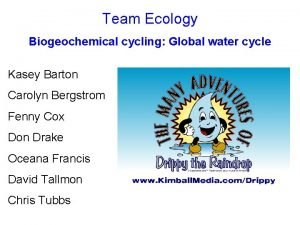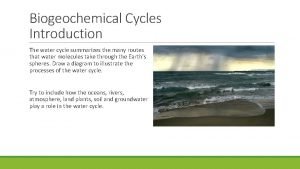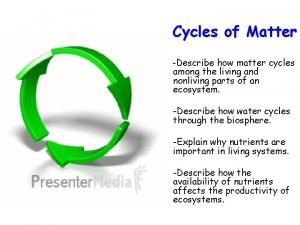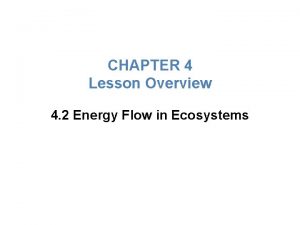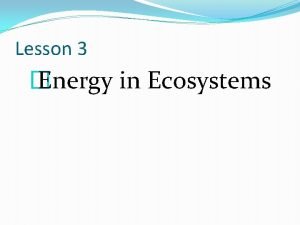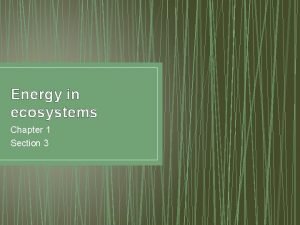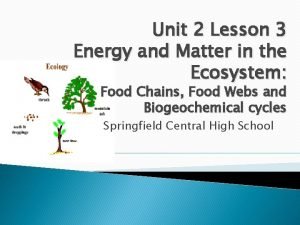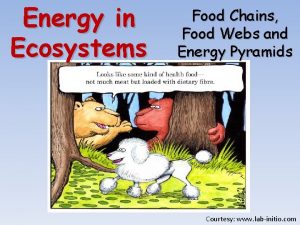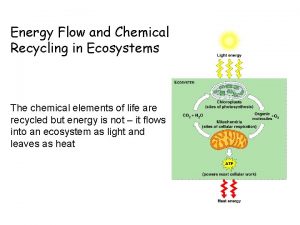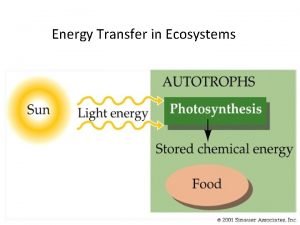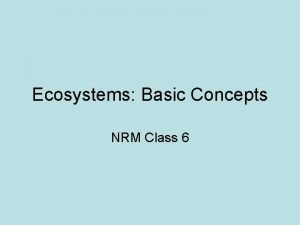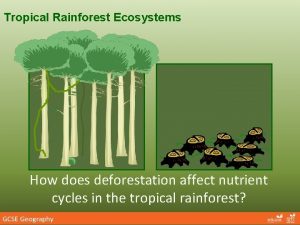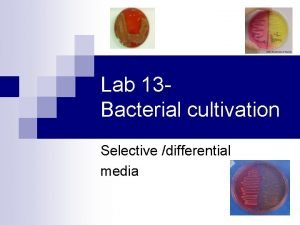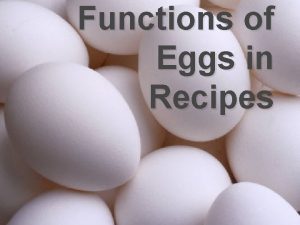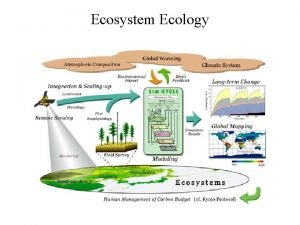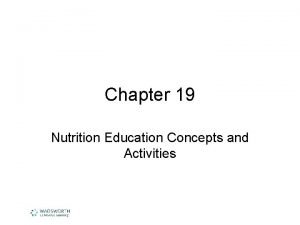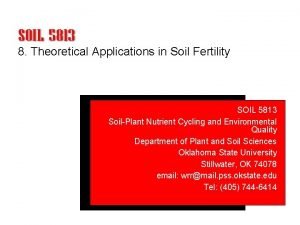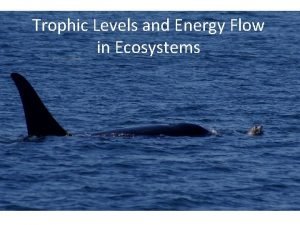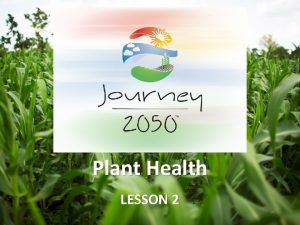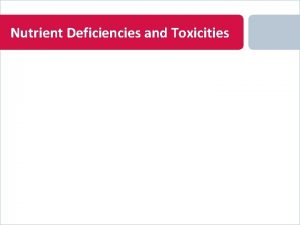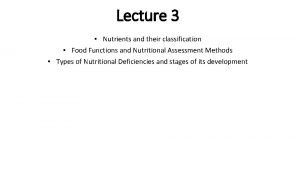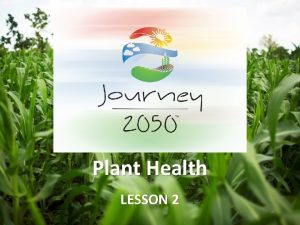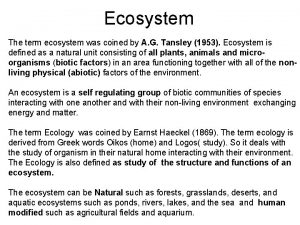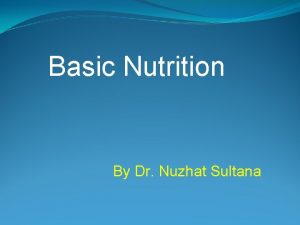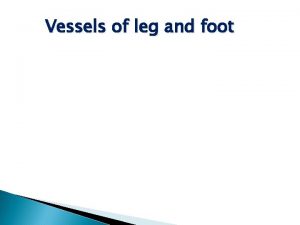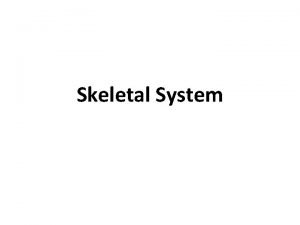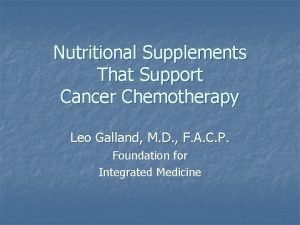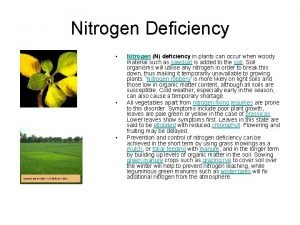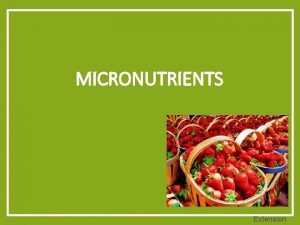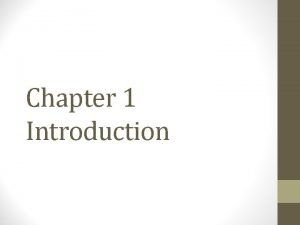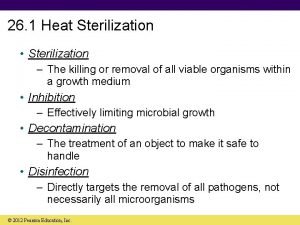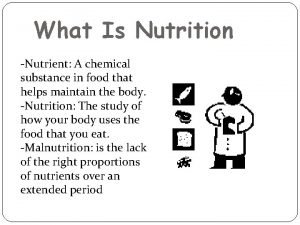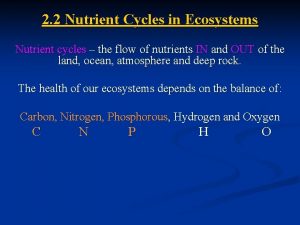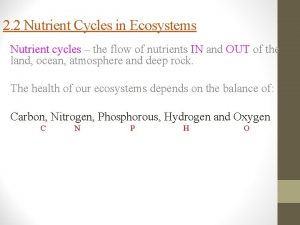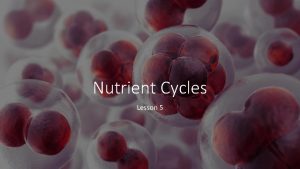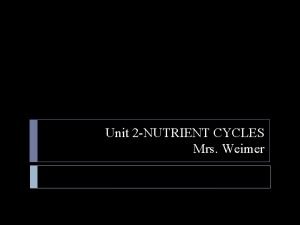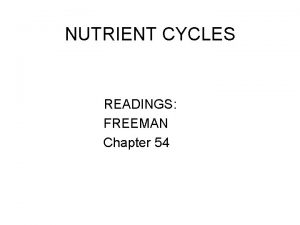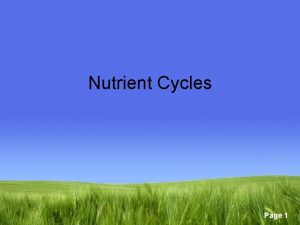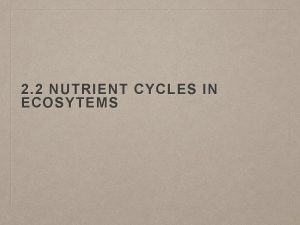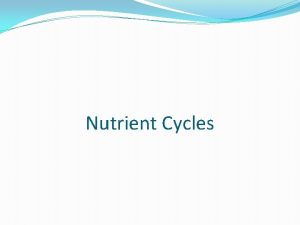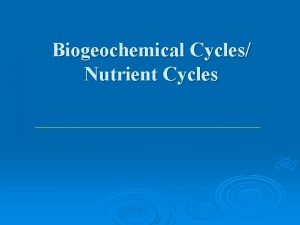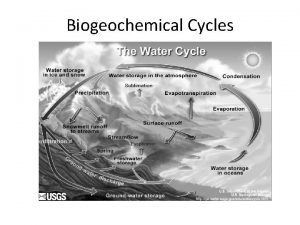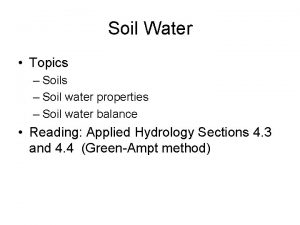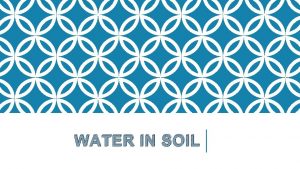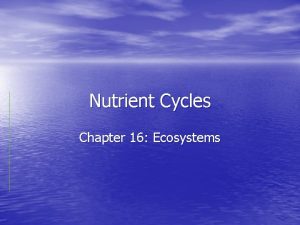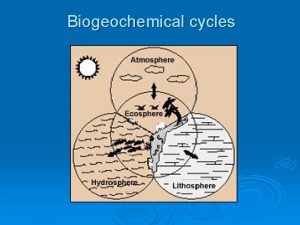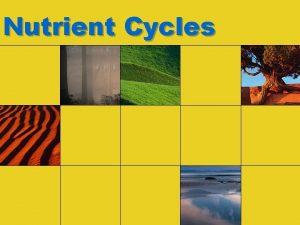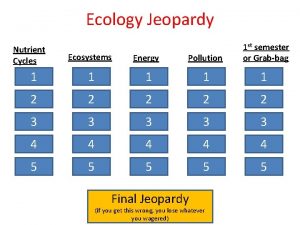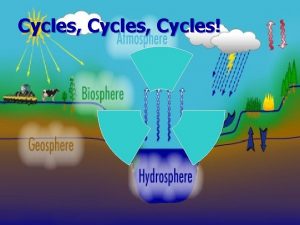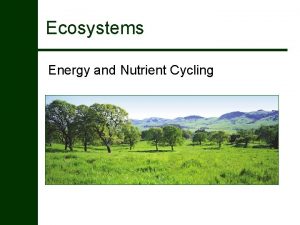Energy Ecosystems Nutrient Cycles Water Soil 100 100



















































- Slides: 51

Energy & Ecosystems Nutrient Cycles Water & Soil 100 100 100 200 200 200 300 300 300 400 400 400 500 500 500 Populations Sustainability

What is an ecosystem?

Includes all organisms in an area that interact with each other and with their environment of E (energy) and matter.

A secondary consumer would be in which trophic level?

Third trophic level

How does ecological niche compare to habitat?

Habitat is an ecological or environmental area that is inhabited by a particular species of animal, plant, or other type of organism. A place where a living thing lives is its habitat. It is a place where it can find food, shelter, protection and mates for reproduction. A Niche is a term with a variety of meanings related to the behaviour of a species living under specific environmental conditions. The ecological niche describes how an organism or population responds to the distribution of resources and competitors and how it in turn alters those same factors.

How much energy is passed along from organisms in one trophic level to the one above it once those organisms are consumed? Where does the energy go?

E transfer it is not 100%. 100 KJ of E in and only 10 KJ will be used effectively by the tissues. The amount of E transferred from one level to the next varies from 5 -20% with 10% being a good average. Where does the rest go? ? ? 30 KJ thermal E to environment, 60 KJ as waste

Why is it that a farm that produces plants will be able to support a larger population of humans then a farm that produces plants and animals How does this relate to marine ecosystems and meeting the needs of humans.


In the long cycle involving phosphorous what ion is important?

Phosphate ion PO 43 -

How is it that the earth can be considered an open and a closed system at the same time?

The earth is closed in terms of nutrients however it is open in terms of energy coming in from the sun.

What is the balanced chemical equation for photosynthesis? What is the name of the structure where this process takes place?

6 CO 2 + 6 H 2 O + E C 6 H 12 O 6 + 6 O 2 Chloroplast

Atmospheric nitrogen (N 2) can not be used by plants or animals. To be used by plants it must be changed to nitrates (NO 3 -). How does this occur ?

Nitrogen Fixation usually by bacteria

How can fertilizer run off affect aquatic ecosytems?

Algal Bloom N and P cause more algae to be created Bacteria use O to break it down No O for aquatic plants and animals

Identify two soil nutrients that are affected by percolation When there is acid deposition, these nutrients will leach deeper into the soil layers creating soil that is nutrient depleted.

K = Potassium Ca = Calcium Mg = Magnesium NH 4+ = Ammonium

When coal is burned what two harmful products are released? These substances are released into the atmosphere and can lead to acid precipitation.

SO 2 & NOx

What factors contribute to the p. H of soil?

p. H of the rain that is falling and the nature of the rock from which the soil was formed. Ca. CO 3 can help to neutralize acid deposition

Soil can be affected by a variety of factors. Explain how two of the following exhibit their effects on soil: urban sprawl crop rotation soil erosion

Urban Sprawl - the expansion of human populations away from central urban areas into low-density, monofunctional and usually car-dependent communities. Crop Rotation - is the practice of growing a series of dissimilar/different types of crops in the same area in sequential seasons. Soil Erosion - is a naturally occurring process that affects all landforms. In agriculture, soil erosion refers to the wearing away of a field's topsoil by the natural physical forces of water and wind or through forces associated with farming activities such as tillage.

In terms of aquatic ecosystems what is dissolved oxygen? What can affect this and why is that of importance?

Dissolved oxygen refers to the level of free, non-compound oxygen present in water or other liquids. It is an important parameter in assessing water quality because of its influence on the organisms living within a body of water.

How does biotic potential compare to carrying capacity?

Biotic Potential Maximum number of offspring that a species could produce if resources were unlimited. Carrying Capacity Maximum number of individuals of a species supported indefinitely by an ecosystem.

What is the difference between intraspecific and interspecific competition? Provide examples of each

Intraspecific Competition – same species Interspecific Competition – different species

Frogs are considered a bioindicator. What does that mean?

Frog populations can indicate whether an ecosystem is safe or not.

How do density dependent and density independent factors compare to each other?

Density dependent factors – aggression, neglect of offspring will decrease birth rate and increase death rate. Density independent factors – fire, flood, extreme weather

What two factors contribute to an increase in a population? What two factors contribute to a decrease in population?

Changes to populations Growth = natality (birth rate); immigration Decline = mortality (death rate); emigration

What is sustainable development?

Development that meets the needs of the present without compromising the ability of future generations to meet their own needs

In terms of pollutants, how does a point source pollutant differ from a non-point source pollutant?

Point source pollution is any single identifiable source of pollution from which pollutants are discharged, such as a pipe. Non-point source pollution does not come from a specific source. Instead, it originates from many places, or from a widespread area.

Why are invasive species important to know about? Select one invasive species and discuss potential economic, environmental and social consequences.

Open ended

What is environmental stewardship?

Environmental stewardship refers to responsible use and protection of the natural environment through conservation and sustainable practices.

Why is a farmer concerned about fertilizing fields for nitrogen and phosphorous however not concerned about adding carbon or energy?

Carbon and energy are absorbed by the plants through photosynthesis
 Nutrient cycles in marine ecosystems
Nutrient cycles in marine ecosystems 100 100 100 100 100
100 100 100 100 100 Venkatraman ramakrishnan medium composition
Venkatraman ramakrishnan medium composition Apes cycles
Apes cycles Nutrient cycle
Nutrient cycle Water and water and water water
Water and water and water water Importance of water cycle
Importance of water cycle Biogeochemical cycles performance task
Biogeochemical cycles performance task Water cycles of matter
Water cycles of matter Explain water pollution
Explain water pollution Living soil vs dead soil
Living soil vs dead soil What are the four spheres of the earth
What are the four spheres of the earth Chapter 4 lesson 2 energy flow in ecosystems
Chapter 4 lesson 2 energy flow in ecosystems Which marine ecosystem contains the fewest producers
Which marine ecosystem contains the fewest producers Section 3 energy in ecosystems
Section 3 energy in ecosystems Chapter 42 ecosystems and energy
Chapter 42 ecosystems and energy How does energy flow in an ecosystem
How does energy flow in an ecosystem Lesson 3 energy and matter in ecosystems answer key
Lesson 3 energy and matter in ecosystems answer key Lab food chains and energy in ecosystems
Lab food chains and energy in ecosystems How does energy move through most ecosystems on earth
How does energy move through most ecosystems on earth Energy flow and chemical recycling in ecosystems
Energy flow and chemical recycling in ecosystems Primary consumers
Primary consumers Section 1 energy flow in ecosystems
Section 1 energy flow in ecosystems Energy transfer in ecosystems
Energy transfer in ecosystems Provides practically all the energy for ecosystems
Provides practically all the energy for ecosystems Energy energy transfer and general energy analysis
Energy energy transfer and general energy analysis Energy energy transfer and general energy analysis
Energy energy transfer and general energy analysis Profunda brachi artery
Profunda brachi artery How does deforestation affect the nutrient cycle
How does deforestation affect the nutrient cycle Six nutrient groups
Six nutrient groups Differential media
Differential media Eggs as an interfering agent
Eggs as an interfering agent Nutrient cycle in the serengeti
Nutrient cycle in the serengeti Gersmehl model deciduous woodland
Gersmehl model deciduous woodland Foods used in nutrition activities should be nutrient-dense
Foods used in nutrition activities should be nutrient-dense Bray nutrient mobility concept
Bray nutrient mobility concept Nutrient chain foldable
Nutrient chain foldable Journey 2050 student handout 2 word search
Journey 2050 student handout 2 word search Nutrient deficiency
Nutrient deficiency Nutrient basics
Nutrient basics What are the classification of nutrients
What are the classification of nutrients Journey 2050 student handout 4 matching activity
Journey 2050 student handout 4 matching activity The term ecosystem was proposed by *
The term ecosystem was proposed by * Nutrition defination
Nutrition defination Lateral malleolar artery
Lateral malleolar artery Parts of a long bone
Parts of a long bone Tamoxifen nutrient depletion
Tamoxifen nutrient depletion Nutrient deficiency in tomatoes
Nutrient deficiency in tomatoes Nutrient interactions
Nutrient interactions Brays nutrient mobility concept
Brays nutrient mobility concept Nutrient agar plate
Nutrient agar plate A chemical substance in food that helps maintain the body
A chemical substance in food that helps maintain the body
